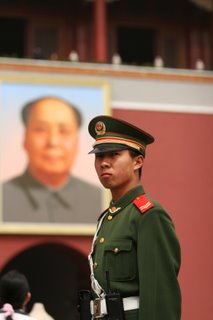
07NOV06 One Day in Beijing
With only one day in Beijing before departing on the new train, I was determined to pack in as many activities as I could! Jetlagged, I awoke early and left my hotel at 7am, walking the 10kms from my hotel to Tianamen Square, the Forbidden City and the People's Hall. Lovely clear and sunny day to join the hordes of Chinese tourists sightseeing in the capital city.


I was quite intrigued by the model Potala Palace that been constructed by the Central Goverment on the fringe of the square, one of the great wonders of "China". The original Potala Palace in Lhasa was built in 641 by Songtsan Gambo, ruler of the Tubo Kingdom, for his new bride, Wen Chen Konjo (Princess Wencheng) of the Tang Dynasty. The Potala Palace has always been the political and religious center of Tibet and home to the Dalai Lama since the fifth Dalai Lama (1645-1693). In 1994, the Potala Palace was declared the United Nations World Cultural Heritage site. It is widely considered to be the world's first "skyscraper" because of it's height and complex construction.
This smaller version was built to commemorate and promote the new Beijing-Lhasa rail service which started this past July, and which I would be riding later that day. Ironic really, considering that the cost of this train is far beyond the means of the average citizen here, and a picture in front of this "Mini-Potala" sitting in Tianamen Square would be as close to Tibet as most of these people would ever get. (On the left-side of the photo you can see the "Great Hall of the People", erected in 1959, the site of the China National People's Congress meetings and an important site for other political and diplomatic activities.)

In contrast to the original Potala Palace in Lhasa (photo taken by me during this trip, Tibet blogs are coming soon.)

Later in the day, I did a rush trip to the Badaling Section of the Great Wall, approximately 70kms outside Beijing city. The Great Wall of China was built mainly to protect the Chinese Empire from the Mongolians and other invaders. The Wall has been periodically rebuilt and modified throughout history by each reigning Chinese dynasty. There are huge discrepancies regarding the length of the wall. Estimates on it's length range between 3,000 to 6,000 kms. Putting this into perspective, the distance from Vancouver to Halifax is approsimately 6,300 kms - that sure is one great wall!
Historical records report that at least one million slaves and prisoners of war were used to create this defensive wall. Many laborers died from exhaustion and starvation while working on this colossal task, and their bodies were added to the rubble and masonry as the quickest means of disposal. For centuries, the Wall was known as "the longest cemetery in the world."

Board the train to Lhasa tonight!


0 Comments:
Post a Comment
<< Home